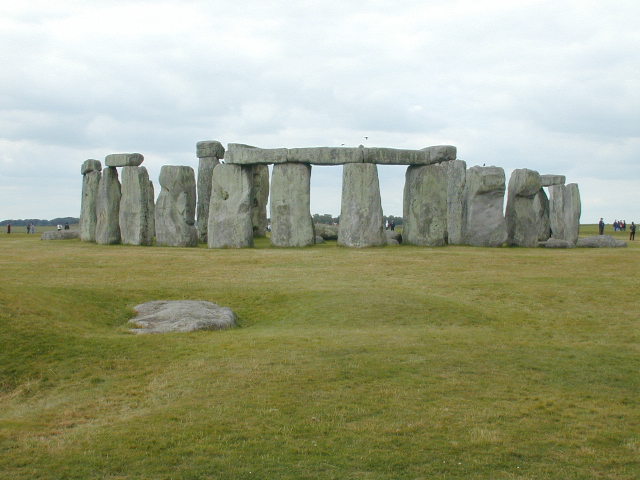

This morning we checked out of our hotel near Oxford and headed north, making two very interesting stops on our way to Wales. First we visited Stonehenge, which is probably the best-known megalithic site in the world. It was first developed with earthworks and probably a wooden structure in about 3000 BC, and then the stone monuments were built up in (at least) two major stages between several hundred and a thousand years later. Visitors are no longer allowed to walk among the stones, to prevent further wear and tear on the site; this meant we couldn't examine its details up close, but also meant our views (and photos!) were uncluttered by all those dang tourists getting in the way...
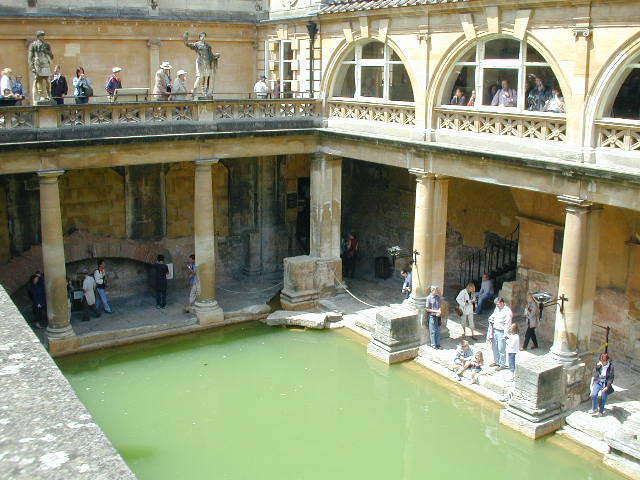
Next we went further north and stopped in the ancient town of Bath. When the Romans conquered this part of Britain in the 1st century AD, they found a local Celtic sacred site here at the only hot springs in the island. (Some of us remarked that the British Isles can't be too geologically active, since earthquakes hadn't knocked Stonehenge down in the last 5000 years!) The attributes of the Celtic goddess Sulis who was worshipped here reminded them of the Roman goddess Minerva (herself borrowed from the Greek Athena), so they built the city of Aquae Sulis (The Waters of Sulis) around the spring and established a temple of Minerva. Wherever the Romans went they built large public bathhouses, so in addition to the center of sacrifice and healing around the spring itself, they built a bath complex using the outflow from the spring. The photo shows the Great Bath, largest of several at the site; because construction atop successive generations of ruins had raised the "street level" about 15 feet between the founding of the city and when the majority of the site was excavated in 1890, the British of a century ago built the columns and terrace you see here, with the original Roman bath in the "basement." (The statues of Roman emperors and generals were also made by the Victorians.) The water would have been clearer in the Romans' time, with measures taken to prevent the growth of algae.
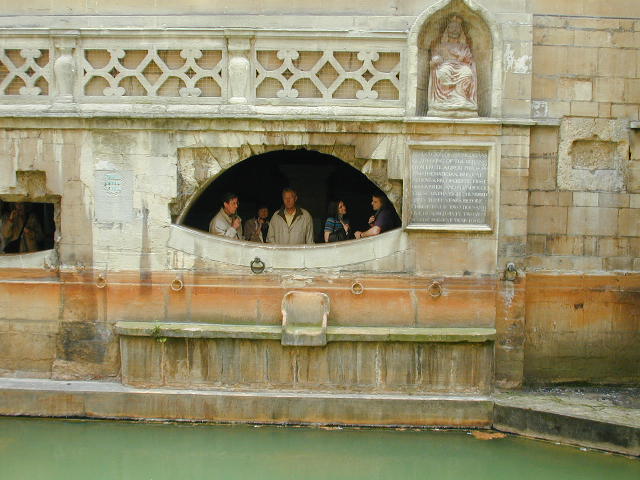
Here you see the Hatlies looking out over the reservoir above the spring itself, which was called the King's Bath during the medieval period (when most of the Roman structures had been ruined and buried, but the spring was still perking). The brown stain shows the water level during that time; the seat is where a person "taking the waters" would sit up to his neck, and the statue inset in the wall is a 17th-century depiction of Bladud, the legendary king who is said to have discovered the springs in the 9th century BC.
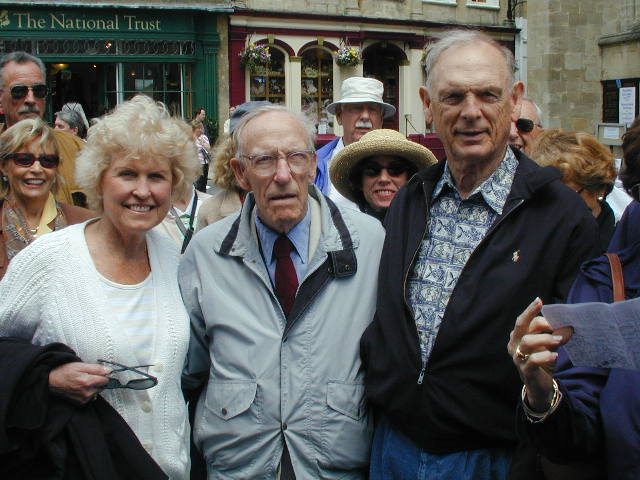
As we arrived at Bath, we were greeted by Ernest Griffiths, here with the Stoltenbergs. The brother of Frances Teague at MBCC, he lives near Bath but has visited southern California enough times that many of the choir knew him and were happy to see him!
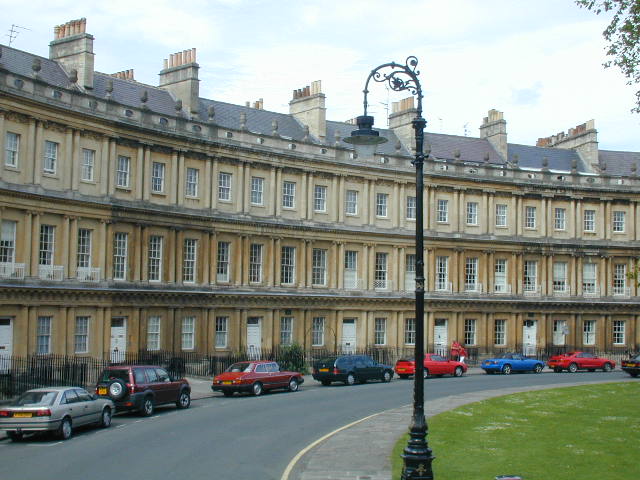
Bath is described as a "Georgian time capsule," because it was a center of British high society during the Georgian period, as the famed curative powers of the waters drew the royal court and other wealthy socialites to the city. Here are some classic "upstairs downstairs" houses, with servants' quarters below ground level (with windows peeking up through the black iron fences), the formal areas of the house on the ground floor, and the family quarters upstairs. I couldn't get a good photo of the famed "Royal Crescent," where the creme de la creme lived; it was like this row but larger and fancier, and I'd swear that it is where they shot the song "Who Will Buy?" that opens the second act of the film of "Oliver!"
The reason the main architecture of the city became frozen as a "time capsule" of the Georgian period is that when the Prince Regent, later King George IV, was taking over the duties of his father King George III in the early 19th century, he decided that sea waters were much more beneficial to one's health than the waters of the hot springs of Bath. He quit going to Bath, and where the king goes the courtiers and socialites follow, so the Big Money flowed out of Bath and no major buildings of later periods displaced the Georgian architecture. Another monarch who didn't have much use for Bath was Queen Victoria; several years before assuming the throne the Princess Victoria came to town to open a park named for her, and a local newspaper reporter had the gall to remark on her rather "dowdy" clothes. She vowed never to see the city again, and even when her railway carriage was passing through town decades later in her reign she ordered the shades to be pulled shut!
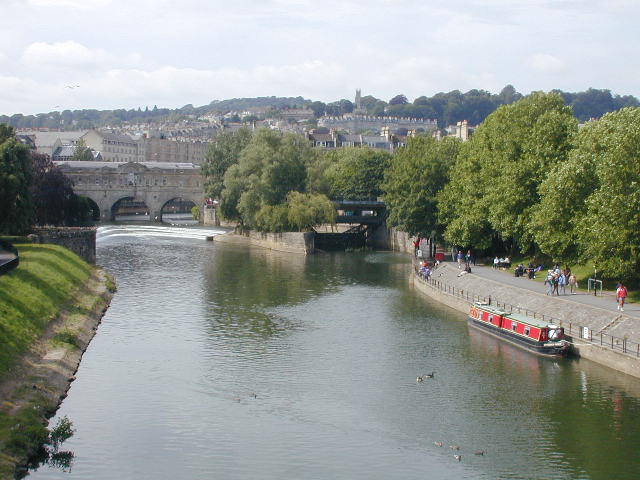
Yesterday I mentioned the "Bridge of Sighs" in Oxford, which was modeled on the original we saw in Venice, but I hadn't posted a photo to which I could link. Well, here is Pulteney Bridge over the River Avon in Bath, a bridge with shops along both sides that is modeled on the Ponte Vecchio we saw in Florence in 1999. There are quite a few rivers named Avon in Britain; apparently this resulted from a misunderstanding on the part of the Romans. At the time they added Britain to their empire, the locals don't appear to have been in the habit of giving names to rivers. Thus when the Romans asked what a river was called, often they'd just be given the Celtic word for "river," which is "Avon," and so they assigned this name to many different streams!
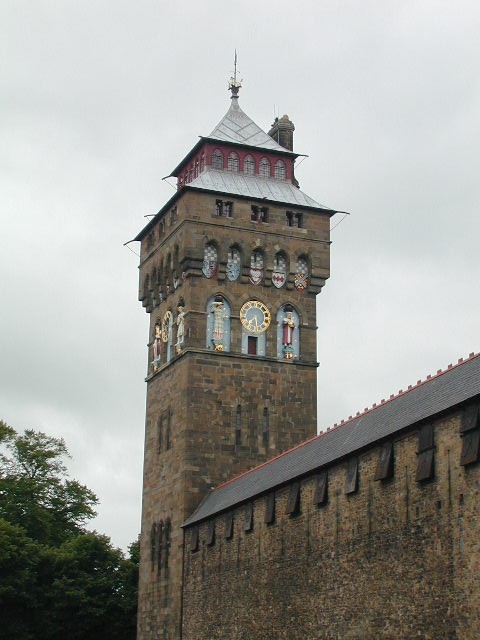
After leaving Bath, we went over the Severn Bridge into South Wales, and stopped at Caerdydd, or Cardiff, capital of Wales. Wales has something like 400 castles, with around 100 open to the public, and after checking into our hotel we crossed the street for a banquet in Cardiff Castle. While the castle was built on the site of ancient Roman fortifications, much of it actually dates only to the 19th century! The third Marquess of Bute had it built in a style that was, as you can see from the tower in the photo, a combination of Gothic and fantasy. In 1947, his grandson gave the castle to the people of Cardiff, and it was until recently the site of the Royal Welsh College of Music and Drama (which numbers Sir Anthony Hopkins among its alumni--anyone for a fine Chianti?).
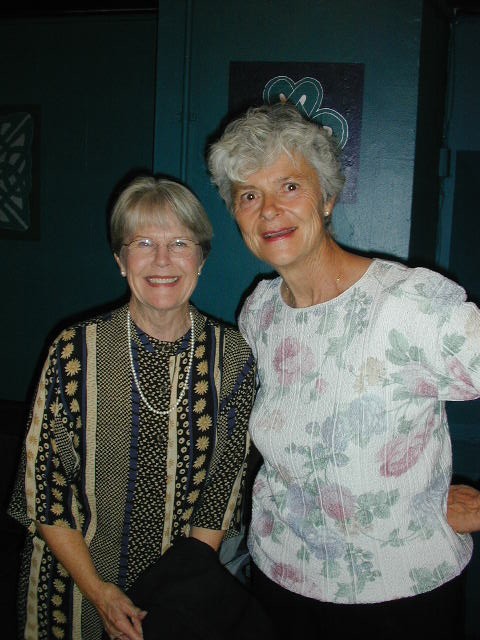
Joining us at the banquet were Barbara Fine, well known to all at MBCC, and her friend Alison Burleigh. The two of them will be traveling independently during our tour, but will be linking up with us occasionally, and we'll be most happy to see them!
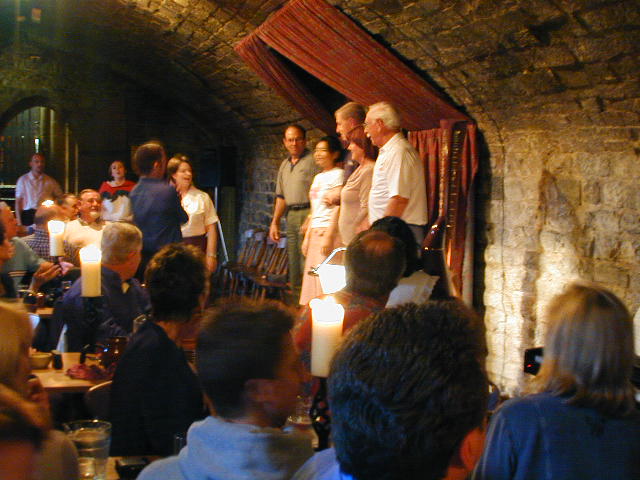
We began with a glass of mead, which is (rather strong!) honeyed wine, accompanied by many a shout of "Yachi da!" ("Good health!") and "Cymru am byth!" ("Wales forever!"), and then had a delicious meal with traditional Welsh vocal and harp music throughout the evening. One of the singers also demonstrated a rapid-fire clog dance, and Robert David, the MC (whose day job is as the castle's interior designer), not only led several songs but also invited us to sing; the choir performed "Cantate Domino," and Jim Sellars sang "Danny Boy." Here you see the MC directing George Jackson, Alan Duncan, Pat Edwards (who knew the song), Warren Jones, and another castle guest as they "go through the motions" for the traditional Welsh song "Franz from Austria" (huh?). One of the castle singers is starting a production and touring company to take Welsh music to the world; we hope they come to southern California so our MBCC friends can hear them!
 To
Sunday, 30 June 2002
To
Sunday, 30 June 2002 Back
to choir tour itinerary
Back
to choir tour itinerarynew 29 June 2002, revised 12 July 2002